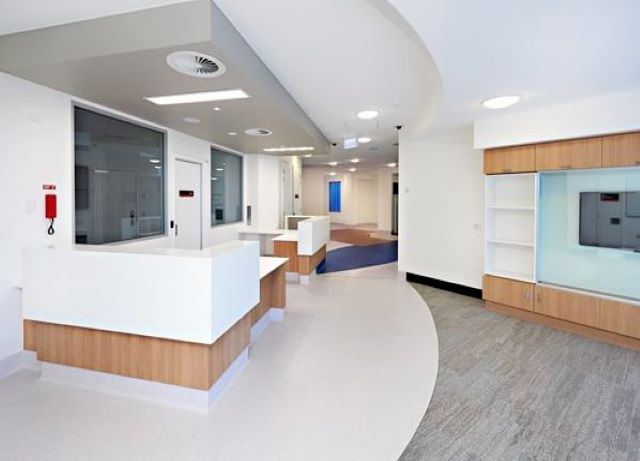Hospitals have many demands every day. These include cleanliness, accessibility, heavy wear, wayfinding, and creating a healing environment. Flooring is an essential part of creating a high-quality care environment. We will show you the various hospital flooring options available and discuss the key requirements that your floors must fulfil in 2022.
Areas for entry
The entrances are the first patients, family members and visitors to your hospital. They are the first to see patrons, help them find services and handle heavy foot traffic. A welcoming, durable floor is essential to your design vision. It should also make a strong impression.
We recommend Terrazzo or Luxury Vinyl Tile (LVT) for entrance areas. Terrazzo is a durable, premium option that can last decades and requires little maintenance. Terrazzo is durable enough to withstand rolling loads and can be used by disabled people. It is also easily recyclable. LVT has even greater design flexibility and durability.
Clinical areas and corridors
Your hospital’s main arteries are corridors. They see heavy foot traffic 24-7. Flooring in corridors must be fast installed and durable to reduce disruptions. You can create clear pathways with patterned or themed flooring in vibrant colours. By supporting an evidence-based design scheme, corridor flooring can reduce stress and promote healing.
The demarcation of walkways or areas where equipment is stored can be used to highlight them.
Rubber or LVT are popular hospital flooring options that meet all these requirements. They can be pre-applied with adhesive backings, which saves time and reduces the amount of work required to install them. The free-floating LVT options can even eliminate the need for adhesives. Protective coatings can be applied to rubber and LVT. This reduces maintenance disruptions and saves time, labour, and chemicals. Both are available in many different textures, colours, and patterns. LVT is a particular imitation of natural textures like wood and stone, with better durability and lower prices than traditional materials.
Operating and emergency rooms
Operating and emergency rooms must adhere to the strictest infection control standards and be accessible 24 hours a day. Easy-to-clean materials are essential to ensure cleanliness. Proper installation and smooth flooring prevent dirt and liquids from getting under your floor.
Hygiene is extremely important in operating rooms and emergency rooms.
Resin flooring can be used in these areas. A properly installed resin floor will provide your facility with a safe, durable, and flexible flooring surface. Resin floors are one the cleanest and most chemical-resistant flooring options on the market. Spills can be cleaned easily by wiping them off, much like a kitchen countertop. They will not settle or sink beneath the surface. Resin flooring has become a popular choice for aesthetic reasons. Industrial resin floors can be customized to meet almost any design idea.
Cafeterias
Stain-resistant, slip-resistant cafeteria floors are the best. A textured, patterned floor can be a great addition to your cafeteria. It will hide and reduce scratches and scuffs. Hospital cafeterias must be designed to promote relaxation and stress reduction.
The cafeteria area should be simple to clean and slip-resistant
Sheet vinyl, LVT and tiles are all options for hospital flooring that can meet these requirements. These tiles are versatile in design and come in various natural textures and vibrant colours. They also have long-lasting durability.
Stations for nurses and treatment areas
These environments are where staff and patients spend the majority of their time. Nurse’s stations are never closed. Flooring should encourage stress reduction, comfort, and 24-hour access. It should be made of materials that are easy to install and require minimal maintenance.
Many hospitals have abandoned traditional Linoleum or vinyl composition tile (VCT) to suit their needs better. Hospitals are now using LVT, bio-based tiles (BBT), and sheet tile flooring made of low-VOC materials. These types of flooring are recommended because they resist scratches and require less waxing, buffing, and chemical cleaning. Installation times for free-floating LVT materials with adhesive backings are reduced and will not disrupt these areas.
Patient rooms
Many hospitals have patient rooms that are designed to resemble home. These rooms don’t require aseptic flooring. This means you have more options in materials, adhesives, and installation methods. You can choose warm and inviting flooring made from natural materials.
The patent room should feel as comfortable and welcoming as possible
LVT, Linoleum, and sheet tile provide natural stone, wood, and tweed looks at a fraction of the cost of natural materials. All of them can be installed quickly. Textile flooring is a new option that offers the look and feel of carpet but with the durability of tile.
Information on choosing hospital flooring
Various rating and evaluation systems have been developed in recent years to assist hospitals in selecting materials that will meet their strict requirements. spc flooring is the best option for hospitals. The following are some of the most important:
- LEED Healthcare — A rating system for flooring developed by the U.S. Green Building Council. It takes into account evidence-based design as well as indoor air quality.
- Green Guide for Health (GGHC) – A best-practices guide for sustainable design, construction, and operation of healthcare facilities
- FloorScore – A rating system created by the Resilient Floor Covering Institute in conjunction with Scientific Certification Systems. It evaluates flooring for VOC emission and compliance with other rating systems.
- EcoScorecard – A composite tool that shows flooring products that are compliant with the most common rating systems



